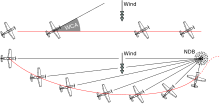Homing (aviation)

Under Homing (dtsch. Returning home ) is understood in the aviation a funknavigatorisches objective approach procedure to a non-directional beacon ( NDB station to fly). The path covered, the target curve , is colloquially referred to as the dog curve . Specifically, it is a radiodrome .
During homing, the heading is corrected so that the aircraft's nose is constantly pointing towards the NDB and the radio compass display (ADF display) always shows a radio lateral bearing (RB) of 000 °. Only when there is no wind, tail wind or head wind does the aircraft have no drift and flies directly to the NDB.
Procedure
- Align the aircraft in the direction of the NDB. This means that the ADF needle must point straight up at the heading marker (RB 000 °).
- Carry out course adjustments in the direction of the needle tip (English. Fly into the needle ).
- Wind from the right means the tip of the needle moves to the right. Change course to the right until the RB is 000 °.
- Wind from the left means the tip of the needle moves to the left. Change course to the left until the RB is 000 °.
The change of the original course or the change of the bearing caused by the wind is called bearing jump in radio navigation . In order not to have to constantly change course, a course correction should be carried out from a bearing jump of 5 °.
Disadvantages of homing
In the event of a crosswind, the aircraft is shifted to the side from the original approach baseline during the flight. Course changes must be made continuously. Thus, the NDB is not approached on the direct (shortest) route, but on a curved path. The destination flight procedure can only be used for the approach to an NDB, but not for the departure.
The disadvantages mentioned are not of great importance for visual flight navigation. Therefore, homing is the common method here to fly to an NDB. The situation is different with instrument flight navigation. An exact approach course is given here. Therefore this method cannot be used there.
Thanks to satellite-based navigation, it is now relatively easy to determine the path over the ground, the target bearing and, from this, the lead angle (WCA) for the direct approach .
literature
- Jeppesen Sanderson: Private Pilot Study Guide. 2000, ISBN 0-88487-265-3
- Jeppesen Sanderson: Private Pilot Manual. 2001, ISBN 0-88487-238-6
- Jürgen Mies: Radio navigation. 1999, ISBN 3-613-01648-6
- Peter Dogan: The Instrument Flight Training Manual. 1999, ISBN 0-916413-26-8
- Walter Air: CVFR textbook. Mariensiel 2001
- Wolfgang Kühr: The private pilot. Technology II. Volume 3, 1981, ISBN 3-921270-09-X